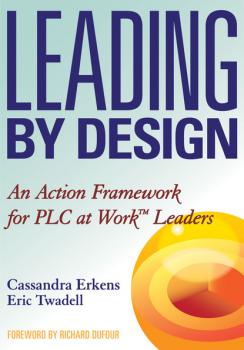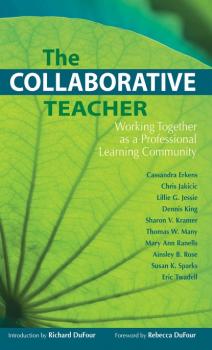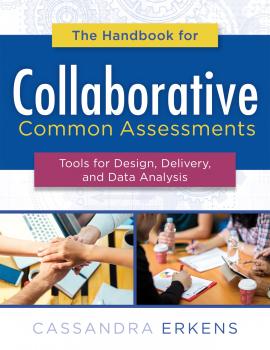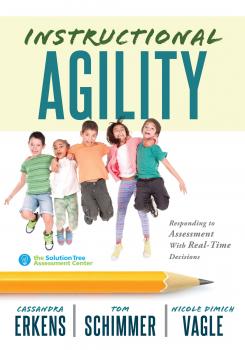Cassandra Erkens
Список книг автора Cassandra ErkensGrowing Tomorrow's Citizens in Today's Classrooms
Rapid innovation is transforming the way people think, work, and connect. For students to succeed today, they must acquire the knowledge and 21st century skills required for college and career readiness. Practical and research-based, this resource will help you design meaningful, relevant skill assessment and instruction that promotes student mastery of critical competencies, including collaboration, problem-solving and critical thinking skills, creative thinking skills, communication skills, digital citizenship, self-regulation, and more. Use the most effective practices for teaching soft skills to increase college and career readiness: Explore the seven critical competencies necessary for success in the 21st century. Become familiar with good habits of mind, and pass those habits on to students to support their soft skill development. Learn how to teach critical thinking and other 21st century skills by facilitating learning that will develop the critical competencies in students. Develop powerful and effective soft skill assessment methods, such as student self-assessments, that will test student levels of competency in the seven critical areas. Access free reproducibles to supplement your understanding of the text and facilitate the book's content in the classroom. Contents: About the Authors Introduction Chapter 1: Cultivating Habits of the Mind Chapter 2: Self-Regulation Chapter 3: Critical Thinking Chapter 4: Collaboration Chapter 5: Creative Thinking Chapter 6: Communication Chapter 7: Digital Citizenship Chapter 8: Social Competence References and Resources Index
Essential Assessment
While much research has revealed which assessment practices have the most positive impact on student achievement and instruction, out-of-date, unproductive practices, which students find disengaging and disheartening, still persist. Discover how to use the power of assessment to instill hope, efficacy, and achievement in your students. With this research-based resource, you’ll explore six essential tenets of assessment—assessment purpose, communication of assessment results, accurate interpretation, assessment architecture, instructional agility, and student investment—that will help deepen your understanding of assessment to not only meet standards but also enhance students’ academic success and self-fulfillment. Benefits Interpret the research-based tenets of assessment that are necessary to maximize all students’ learning. Gain advice and strategies for immediately acting on the six essential assessment tenets, including how to communicate assessment results to give feedback that produces constructive responses . Discover why it is vital that assessment practices build students’ and teachers’ hope, efficacy, and achievement. Consider scenarios that illustrate traditional, outmoded assessment practices and revised scenarios that feature practices that better reflect modern assessment needs. Reflect on questions related to the content of each chapter and study next steps that teaching teams can take. Contents Introduction Chapter 1: Hope, Efficacy, and Achievement Chapter 2: Assessment Purpose Chapter 3: Communication of Assessment Results Chapter 4: Accurate Interpretation Chapter 5: Assessment Architecture Chapter 6: Instructional Agility Chapter 7: Student Investment References Index
Leading by Design
By focusing on what students learn rather than what they are taught, schools can redefine their mission and begin the transition to a professional learning community. After interviewing and observing principals, administrators, and teachers, the authors identify seven leadership practices that effective PLC leaders share, along with the techniques that have led them to sustainable success.
Collaborative Teacher, The
The time of exclusive top-down leadership is over! Only teachers can transform education from inside the classroom, and this book defines best practices of collaborative teacher leadership. Specific techniques, supporting research, expert insight, and real classroom stories illustrate how to work together for student learning, create a guaranteed and viable curriculum, and use data to inform instruction.
The Handbook for Collaborative Common Assessments
When educators participate fully in the consistent and systematic process of collaborative common assessments, teachers, learners, and schools all thrive. A companion to the assessment book Collaborative Common Assessments by Cassandra Erkens, this practical handbook presents measures teams can take to improve their collaborative common assessments. Each chapter features reflection questions as well as tools and protocols for implementing each phase of the process. Use this practical handbook to improve your collaborative common assessment process: Gain a deeper understanding of the collaborative assessment process. Discover how to ensure the accuracy and reliability of collaborative common assessments in analyzing student assessment data. Identify student misconceptions in the classroom to better plan educational interventions and collaborative instruction. Answer reflection questions to ensure collaborative teams are concentrating on the right work. Contents: Introduction: Teamwork, Instruction, Results Chapter 1: Foundational Concepts of Collaborative Common Assessment Chapter 2: Evidence and Research Supporting the Collaborative Common Assessment Process Chapter 3: The Preparation Phase Chapter 4: The Design Phase Chapter 5: The Delivery Phase Chapter 6: The Data Phase Chapter 7: The Re-Engagement Phase Epilogue References and Resources
Instructional Agility
The true power of assessment comes when emerging results determine what comes next in student learning. This practical book empowers educators and their teams, schools, or districts to move seamlessly between instruction, formative assessment, and feedback, improving school culture more effectively than traditional methods. Instructional agility enhances ownership of learning, proficiency, and motivation for students, and promotes a positive school culture. Each chapter concludes with reflection questions that assist readers in determining next steps for supporting the whole child and the whole learning process. Learn how to promote an agile culture of learning in school to increase student ownership of learning: Discover how instructional agility fits within the six tenets of the essential assessment framework. Learn how to foster and maintain a culture of learning in schools. Gain strategies and tools to enhance instructional agility and assessment practices. Examine examples of instructional agility in action. Consider questions that help individual teachers and learning teams contemplate what they learned and their next steps for implementing for instructional agility strategies. Contents: Chapter 1: Establishing a Culture of Learning Chapter 2: Engineering Engaging Conversations Chapter 3: Questioning Chapter 4: Observing Chapter 5: Mobilizing Chapter 6: Practicing Chapter 7: Fostering a Culture of Instructional Agility References and Resources
Collaborative Common Assessments
Reignite the passion and energy assessment practices bring as tools to guide teaching and learning. Strengthen instructional agility in professional learning communities with collaborative common assessments that collect vital information and consider all levels of the organization. Explore the practical steps teacher teams must take to establish clear, comprehensive assessment systems, and discover how to continually improve results.






